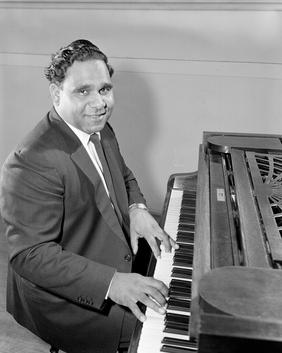Harold Blair facts for kids
Quick facts for kids
Harold Blair
|
|
|---|---|

Blair at piano 1958
|
|
| Born | September 13, 1924 |
| Died | May 21, 1976 (aged 51) |
| Nationality | Australian |
| Occupation | Tenor (singer) |
Harold Blair (born September 13, 1924 – died May 21, 1976) was a famous Australian singer, known as a tenor (a high male singing voice). He was also an important activist who worked for the rights of Aboriginal people. Many people called him the "last great Australian tenor of the concert hall era." This means he was one of the last big opera singers who performed in large concert halls during that time.
Contents
Harold Blair's Early Life
Harold Blair was born on September 13, 1924, in Cherbourg, Queensland. This place was then called the Barambah Aboriginal Reserve. His mother was Esther Quinn, a young Aboriginal woman. Harold's last name, Blair, came from the family who had "adopted" his mother.
When Harold was two years old, he and his mother moved to the Salvation Army Purga Mission near Ipswich, Queensland. His mother worked as a domestic helper, and Harold stayed at the mission. There, he received his basic education. Harold left school at age 16 and started working as a farm labourer.
Discovering His Singing Talent
At 17, Harold was driving a tractor at the Fairymead Sugar Mill. A trade union organiser named Harry Green heard him singing. Harry was very impressed and encouraged Harold to become a professional singer.
In 1944, Harold began performing with other artists. They raised money for charities and patriotic causes. In March 1945, he entered a radio talent show in Brisbane. He received a record number of votes from listeners!
The Queensland government offered to pay for his music training, but he didn't take up the offer. Instead, a group of people, including trade union members, university professors, and musicians, created a special fund to help him. They wanted to support his singing career.
Harold Blair's Singing Career
In 1945, Harold Blair started studying at the Melba Conservatorium in Melbourne. He worked very hard and earned a Diploma of Music with honours in 1949.
In 1950, a famous African-American singer named Todd Duncan invited Harold to study in the United States. Harold went to the Juilliard School in New York. While in New York, he sang in a church in Harlem and became part of the local community.
Touring Australia
In 1951, the Australian Broadcasting Commission (ABC) offered Harold a three-year singing contract. This contract included a big tour to celebrate 50 years of Australia's Federation.
Harold's performances included many European classical songs. He sang German lieder, Italian opera, and French art songs. He also performed works in English by Handel and Southern spirituals. Importantly, he also shared traditional Aboriginal songs with his audience. These included "Nananala Kututja" and "Maranoa Lullaby."
During his tour, Harold had to cancel one concert because of a bad cold. He later had laryngitis, which affected his voice. He decided to stop public performances for a while to focus on his studies.
Because he broke his contract with the ABC, he couldn't sing professionally for three years. This was discouraging for him. Harold then found other jobs, including working in a hardware store. He also became interested in education and later taught at Ringwood Technical School. He even taught at the Conservatorium in Melbourne and served on the Aboriginal Arts Board.
Working for Aboriginal Rights
Harold Blair was a strong supporter of Aboriginal rights throughout his life. He joined groups like the Aboriginal Advancement League and the Federal Council for the Advancement of Aborigines and Torres Strait Islanders.
In 1962, he saw a group of Aboriginal marching girls at an event called Moomba. This inspired him to start the Aboriginal Children's Holiday Project. This project helped thousands of Aboriginal children spend school holidays in private homes in Melbourne and Sydney.
Harold was also an early member of the Aborigines Welfare Board in Victoria. In 1963, he even ran for a political position. He was a candidate for the Australian Labor Party in the Mentone area of the Victorian Parliament.
Harold Blair's Personal Life
Harold Blair married Dorothy Eden, a fellow singing student, on July 30, 1949. They had two children, Nerida and Warren. At the time, their marriage faced some challenges because it was between an Aboriginal man and a European woman. Harold is survived by three grandchildren. He also had twin half-sisters, Joy and June Thompson, with whom he stayed in touch. Harold's favourite sport was Australian rules football.
Honours and Recognition
Harold Blair received many honours for his work and talent:
- In 1976, he was made a Member of the Order of Australia (AM). This is a high honour given to Australians for their achievements.
- The Australian Electoral Division of Blair in Queensland, created in 1998, is named after him. This means a voting area in Australia is named in his honour.
- In 2012, the Melba Opera Trust started the Harold Blair Opera Scholarship. This scholarship helps young Indigenous singers develop their artistic skills and get performance opportunities.
- In 2013, Harold Blair was added to the Victorian Aboriginal Honour Roll. This recognizes his important contributions.
Harold Blair passed away in Melbourne on May 21, 1976, at the age of 51. Many believe his most lasting achievement was his Aboriginal children's holiday project.

